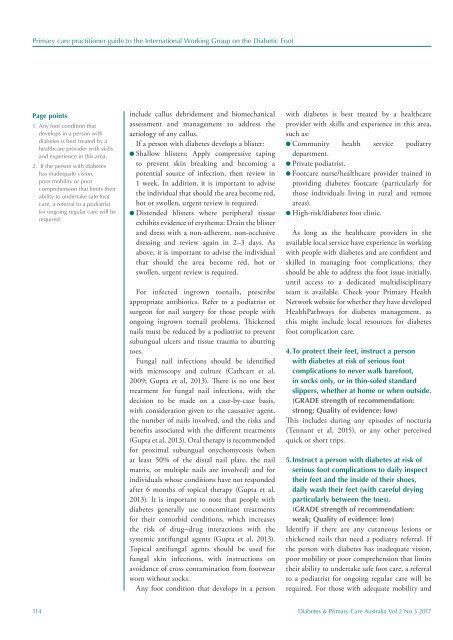DPCA 2-3_entire_v3
You also want an ePaper? Increase the reach of your titles
YUMPU automatically turns print PDFs into web optimized ePapers that Google loves.
Primary care practitioner guide to the International Working Group on the Diabetic Foot<br />
Page points<br />
1. Any foot condition that<br />
develops in a person with<br />
diabetes is best treated by a<br />
healthcare provider with skills<br />
and experience in this area.<br />
2. If the person with diabetes<br />
has inadequate vision,<br />
poor mobility or poor<br />
comprehension that limits their<br />
ability to undertake safe foot<br />
care, a referral to a podiatrist<br />
for ongoing regular care will be<br />
required.<br />
include callus debridement and biomechanical<br />
assessment and management to address the<br />
aetiology of any callus.<br />
If a person with diabetes develops a blister:<br />
l Shallow blisters: Apply compressive taping<br />
to prevent skin breaking and becoming a<br />
potential source of infection, then review in<br />
1 week. In addition, it is important to advise<br />
the individual that should the area become red,<br />
hot or swollen, urgent review is required.<br />
l Distended blisters where peripheral tissue<br />
exhibits evidence of erythema: Drain the blister<br />
and dress with a non-adherent, non-occlusive<br />
dressing and review again in 2–3 days. As<br />
above, it is important to advise the individual<br />
that should the area become red, hot or<br />
swollen, urgent review is required.<br />
For infected ingrown toenails, prescribe<br />
appropriate antibiotics. Refer to a podiatrist or<br />
surgeon for nail surgery for those people with<br />
ongoing ingrown toenail problems. Thickened<br />
nails must be reduced by a podiatrist to prevent<br />
subungual ulcers and tissue trauma to abutting<br />
toes.<br />
Fungal nail infections should be identified<br />
with microscopy and culture (Cathcart et al,<br />
2009; Gupta et al, 2013). There is no one best<br />
treatment for fungal nail infections, with the<br />
decision to be made on a case-by-case basis,<br />
with consideration given to the causative agent,<br />
the number of nails involved, and the risks and<br />
benefits associated with the different treatments<br />
(Gupta et al, 2013). Oral therapy is recommended<br />
for proximal subungual onychomycosis (when<br />
at least 50% of the distal nail plate, the nail<br />
matrix, or multiple nails are involved) and for<br />
individuals whose conditions have not responded<br />
after 6 months of topical therapy (Gupta et al,<br />
2013). It is important to note that people with<br />
diabetes generally use concomitant treatments<br />
for their comorbid conditions, which increases<br />
the risk of drug–drug interactions with the<br />
systemic antifungal agents (Gupta et al, 2013).<br />
Topical antifungal agents should be used for<br />
fungal skin infections, with instructions on<br />
avoidance of cross contamination from footwear<br />
worn without socks.<br />
Any foot condition that develops in a person<br />
with diabetes is best treated by a healthcare<br />
provider with skills and experience in this area,<br />
such as:<br />
l Community health service podiatry<br />
department.<br />
l Private podiatrist.<br />
l Footcare nurse/healthcare provider trained in<br />
providing diabetes footcare (particularly for<br />
those individuals living in rural and remote<br />
areas).<br />
l High-risk/diabetes foot clinic.<br />
As long as the healthcare providers in the<br />
available local service have experience in working<br />
with people with diabetes and are confident and<br />
skilled in managing foot complications, they<br />
should be able to address the foot issue initially,<br />
until access to a dedicated multidisciplinary<br />
team is available. Check your Primary Health<br />
Network website for whether they have developed<br />
HealthPathways for diabetes management, as<br />
this might include local resources for diabetes<br />
foot complication care.<br />
4. To protect their feet, instruct a person<br />
with diabetes at risk of serious foot<br />
complications to never walk barefoot,<br />
in socks only, or in thin-soled standard<br />
slippers, whether at home or when outside.<br />
(GRADE strength of recommendation:<br />
strong; Quality of evidence: low)<br />
This includes during any episodes of nocturia<br />
(Tennant et al, 2015), or any other perceived<br />
quick or short trips.<br />
5. Instruct a person with diabetes at risk of<br />
serious foot complications to daily inspect<br />
their feet and the inside of their shoes,<br />
daily wash their feet (with careful drying<br />
particularly between the toes).<br />
(GRADE strength of recommendation:<br />
weak; Quality of evidence: low)<br />
Identify if there are any cutaneous lesions or<br />
thickened nails that need a podiatry referral. If<br />
the person with diabetes has inadequate vision,<br />
poor mobility or poor comprehension that limits<br />
their ability to undertake safe foot care, a referral<br />
to a podiatrist for ongoing regular care will be<br />
required. For those with adequate mobility and<br />
114 Diabetes & Primary Care Australia Vol 2 No 3 2017
















